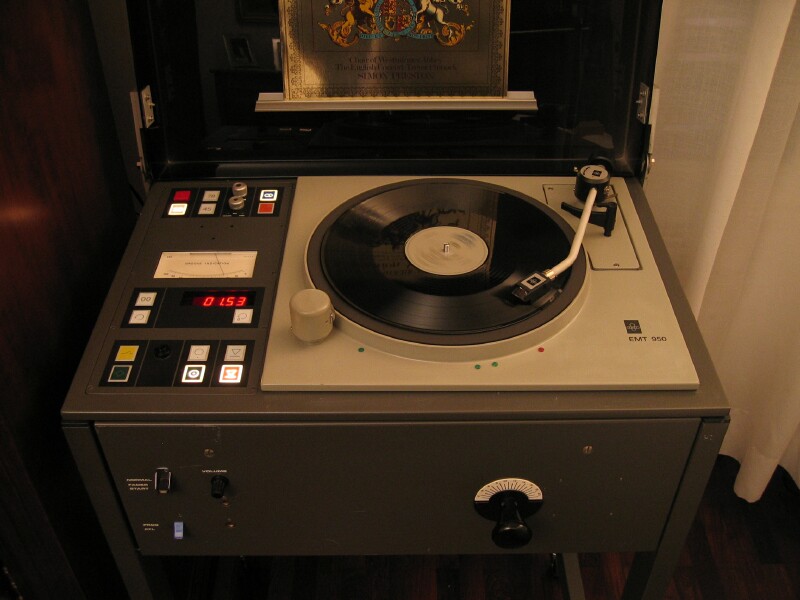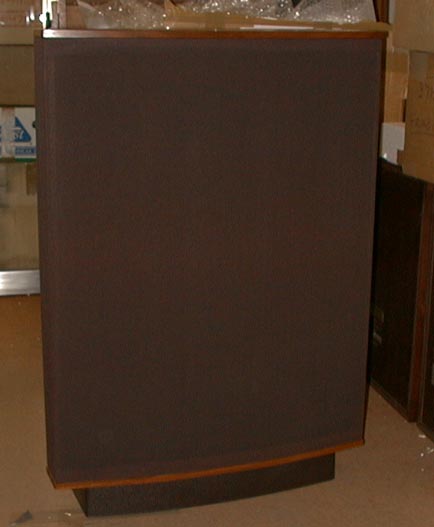
The ‘BBC’ 950
So you want a machine that can play music from a disc and you need instant cueing, automatic recall of the beginning of a track on a disc, digital time counter in seconds/minutes, constant visualization of the position of the pick-up on the disc….no problem sir, just look at a good professional CD reproducer.
Hey, but this is 1980, two full years before the birth of CD! All we have now is analogue turntables…Normal turntables on a 33 rpm vinyl record wouldn’t offer these facilities! What, sir? Money no object? Oh well, sir, on a second thought it might be arranged…. EMT will build a machine for your needs, a machine that puts to good use all the advances of high-end design and building to incorporate all the features that are so obviously desirable for professional applications. Yes sir, they’re unheard-of before. No other manufacturer has ever dared to build a similar machine. EMT is a conservative firm renowned for its avant-garde designs…..
The EMT ‘9 950 347’, or, as it is more widely known, the ‘BBC’, was one of the final developments of the most formidable professional record player ever manufactured, the EMT ‘950’. This impressive machine appeared in 1976 as a complete revolution in the conservative line-up of the Kippenheim firm: the legendary factory founded by Wilhelm Franz had traditionally based its success on the massive idler-wheel machines built since 1948 (EMT 927, 930) but with the death of the founder, in 1971, it had adopted a different strategy. The new broadcast-quality EMTs, especially the flagship of the range, were based on an efficient direct-drive system and very complex electronics that allowed a very quick start-up time and braking, essential for cueing in radio environment. Sturdiness, stability and overall reliability were priorities of this futuristic machine; as money was no object, the end result was a 75-kgs monument to the technique of record reproducing.
Built as a battleship, and (probably not casually) painted in the same shade of medium gray, the ‘950 Schallplatten-Wiedergabe-Maschine’ was and still is impressive. Its performance is shattering: wow, flutter and rumble were simply too low to be measured at the time, the start-up time of 200 msec was appropriate for broadcast cueing as was the possibility of turning the record backwards to the touch of a button to search for the desired cueing point. The superb 929 tonearm was a fitting complement to this formidable machine.
The 950 was undoubtedly way too complex and expensive for normal customers, but it enjoyed immediately a healthy success amongst the premium pro market, the ‘money-no-object’ high spenders of the main broadcast corporations. RAI, SR, SDR, FR all bought their own versions of the 950; relatively few were the standard machines, most of the 950 being ‘customized’ by the factory to the special order of the customer. Typical of this was the Italian RAI version (‘9 950 322’) with stylus illuminator on the right side of the chassis, no antiskating, no auto 33/45 rpm selection; its 929 arm was modified to use standard SME-type shells. Some German radios preferred ‘narrow’ machines (‘950E’, versions ‘9 950 2**’), others the basic ‘standard’ machine (‘9 950 1**’) as did Danish and Swedish broadcasters but with MC cards and TSD 15 Tondosen. Austrian radios (ORF) ordered mainly ‘narrow’ 950s equipped with the uncommon Lemo connectors in place of the standard XLRs (‘9 950 810’). Click here for an (incomplete) list of the 950 'variants'.
The ultimate ‘customization’ of the 950, though, arrived in the early Eighties with an order from the famed British Broadcasting Corporation. The BBC had used for years Garrard 301s and 401s, then the Technics SP-10, but the overall quality and operation facilities of the 950 made it the natural choice also for the mighty BBC. For reason we don’t know, however, the British wanted some very special ‘accessories’ for their machines, and this is where the history becomes quite interesting.
The ‘347’ is built on the chassis of a standard machine, so the console on the left of the platter carries the on/off switch, speed selector (33, 45 and 78 rpm), remote control on/off, stereo/mono selector and arm lift. In the standard 950 the ample space in the central part of the console is reserved to the monitor speaker; in the ‘BBC’ the speaker is deleted and its place is occupied by a ‘groove indicator’, a large analogue instrument that shows the position of the needle on the platter on a scale graduated from ‘0’ (the first groove) to ‘100’ (the last groove). This dial is reminiscent of the one installed since the early Fifties on the ‘927A’, and, though not essential, it is a welcome feature for professional use.
Much more interesting, and a real novelty about professional machines, is the ‘zero locator’. This is a sort of sophisticated digital chronograph connected to the start/stop/reverse functions of the 950. This digital time counter starts every time that the platter starts turning. It has a reset (‘zero’) button that locates a desired cueing point and another button that uses the reverse of the 950 to take the platter automatically back to that cueing point (where the counter was reset). This is a very useful cueing tool.
This is not all. The ‘347’ also sports a ‘Vario Control’. This device, very rare on any 950 (after all, EMT guaranteed a perfect speed of its machines in any condition without any need for manual intervention), is useful to play discs recorded to non-standard speeds (like several early 78’s). Should the need arise, the user can use this control on either ‘coarse’ or ‘fine’ level to obtain the desired playback speed.
The only missing facility in this complex machine is the stylus illuminator, evidently deemed not so necessary by British engineers, but it can be installed anyway as a very useful ‘retrofitting’. On the other hand, BBC found advantageous to fit several more controls on the front panel of the ‘347’. On the same panel the ‘347’ has a Penny & Giles potentiometer and two more switches: one normal-fader start that allows to start the record player from a mixer or from a local button; a ‘normal-pfl’ switch that allows the user the monitoring of the program with a headphone (the level is controlled via a separate potentiometer); and an on/off switch for the built-in 950 muting.
The signal output of the ‘9 950 038’ MM phono card (it is obviously possible to install the ‘088’ card for Moving Coil cartridges), after the amplification in the preamp, is sent from the standard XLR connectors on the back of the 950 to the P&G potentiometer and then to a large proprietary connector situated under the deck. From this unusual connector the ‘umbilical cord’ goes to the input of the studio mixer.
The whole machine is protected (this is truly appreciated) by a large Perspex cover thoughtfully incorporating a record-cover holder. Finally, the ‘347’ sits 10 cms higher than the standard 950s, whose massive metallic legs are 73 cms tall (without the adjustable feet) whilst the British machines’ are 83 cms tall. Weight of the ‘9 950 347’ is nearly 76 kilograms.
Do you need a ‘9 950 347’? To be honest, not really…if you’re not a really hard-core EMT enthusiast and, let’s be frank, expert, it may be too much to handle. If a ‘347’ would be your first experience with EMTs, don’t buy one. Some time ago a guy provoked a very unpleasant quarrel on several online audio Forums because he had bought one of these turntables from a British seller and was not happy with the machine he got. I don’t want to speak about the terms he had with the seller of the turntable, as I don’t know either him or the buyer. (BTW: this guy also told that I was responsible for recommending the seller that he accused of being a crook. I obviously answered that the seller’s fault, if there was a fault, is not mine, I had bought a splendid 948 from him some years ago and if someone wants to buy a machine from a seller mentioned on my site it would be just polite to send a mail asking for a confirmation of all this, but his Far East guy was extremely rude and his pettiness made the whole thing quite sad.)
Anyway, the bottom line was that this guy didn’t actually know what an EMT is; he bought it just as a fashion accessory; but he wasn’t prepared to spend the money to buy it from a dealer where he could actually see and check the machine. He decided to go the cheap route via Net and, to add all the possible risks to his own lack of experience, he decided to buy a ‘BBC’ because of its bells and whistles. Obviously, he was unprepared to handle such a complex machine, and the result was that he was unhappy and tried to put all the blame on the seller.
The ‘BBC’ is not a machine that you can buy without seeing it and you need a minimum of experience to work on it, not just a pile of money to purchase one. This is obviously true of every high-quality equipment, but probably it is even more true of a 20+years old very sophisticated and complicated machine. Try buying a Nagra IV-S for pennies and pretend to have it working as new…..
Is the '9 950 347' the ultimate EMT? Perhaps somebody else will love more the classic '930', the monumental '927', the compact '928' or other versions of the '950', but for me the 'BBC', with its devices, is like a Patek Philippe 'Grande Complication' : the final evolution of the professional machine devoted to the reproduction of the most classic audio design, the vinyl record.
Citeret fra Stefano Pasinis hjemmeside.
Hvis jeg anskaffede mig sådan en, ville det også kræve en
Gammel Mercer:

Og muligvis tidsvarende Vokuhila aka Bundesligahår
Har I lignende ideer?











